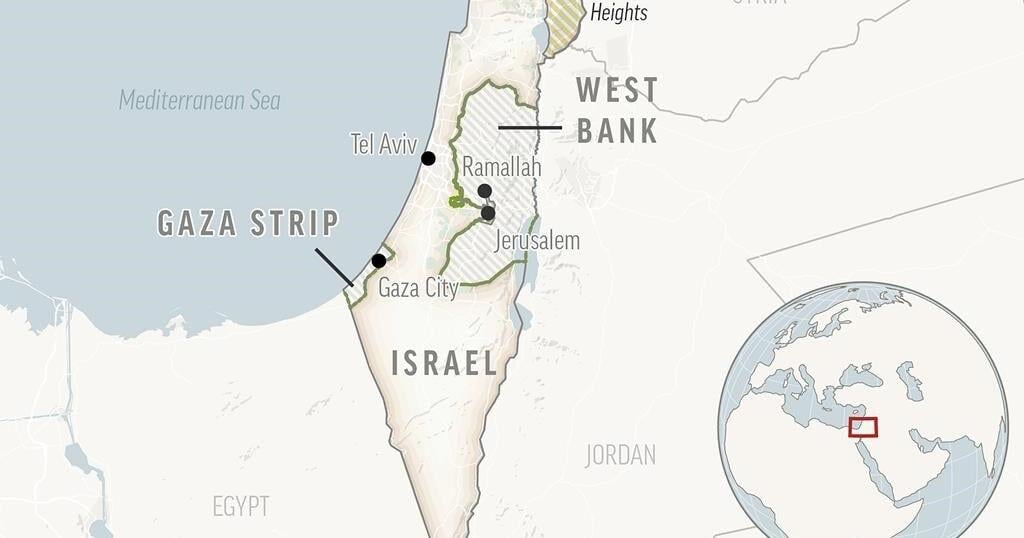DEIR AL-BALAH, Gaza Strip (AP) — Israeli strikes on homes in the northern Gaza Strip overnight and into Sunday left at least 87 people dead or missing, the territory’s Health Ministry said, as a large-scale operation continued against Hamas militants said to be regrouping.
The ministry said another 40 people were wounded in the strikes on the town of Beit Lahiya, which was among the first targets of Israel’s ground invasion nearly a year ago. The Israeli military said it carried out a strike on a Hamas target.
Palestinian officials say hundreds of people have been killed in Israel’s two-week operation in northern Gaza, and that the health sector there is close to collapse.
The United States, meanwhile, was investigating an unauthorized release of classified documents indicating that Israel was moving military assets into place for a military strike in response to Iran’s ballistic missile attack on Oct. 1., according to three U.S. officials who spoke on the condition of anonymity because they were not authorized to discuss the matter publicly.
Iran supports both Hamas and the Lebanon-based Hezbollah.
The U.S. is urging Israel to press for a cease-fire in Gaza following the killing of Hamas leader Yahya Sinwar last week. But neither Israel nor Hamas has shown interest in such a deal after months of negotiations sputtered to a halt in August.
Lebanese army says 3 soldiers killed in Israeli strike
A year of escalating tensions between Israel and Hezbollah boiled over into all-out war last month. Israel sent ground troops into Lebanon early this month.
The Lebanese army said three soldiers were killed in an Israeli strike Sunday on their vehicle in southern Lebanon. There was no immediate comment on that from the Israeli military, which said it struck more than 100 Hezbollah targets in southern Lebanon in the past day and continued ground operations there.
Lebanon’s army has largely kept to the sidelines in the war. The military is a respected institution in Lebanon but is not powerful enough to impose its will on Hezbollah or defend the country from an Israeli invasion.
Israel’s military said Hezbollah fired more than 170 rockets into the country on Sunday. Israel’s Magen David Adom rescue service said three people were lightly injured from a fire sparked by a rocket attack on the northern city of Safed.
Israel has increased strikes on southern neighborhoods of Beirut known as the Dahiyeh, a crowded residential area where Hezbollah has a strong presence. It is also home to many civilians unaffiliated with the militant group.
U.S. Defense Secretary Lloyd Austin has called civilian casualties in Lebanon “far too high” in the Israel-Hezbollah war and urged Israel to scale back some strikes, especially in and around Beirut.
Medics warn of a catastrophic situation in Gaza
Among the dead from the strikes in Beit Lahiya were parents and eight children, according to Raheem Kheder, a medic. He said the strike flattened a multi-story building and at least four neighboring houses.
The Israeli military said it used precise munitions against a Hamas target. It said the area is an active war zone and it is trying to avoid harming civilians.
Mounir al-Bursh, director general of the Health Ministry, said the flood of wounded from the strikes compounded “an already catastrophic situation for the health care system” in northern Gaza, in a post on X.
Doctors Without Borders, the international charity known by its French acronym MSF, called on Israeli forces to immediately stop their attacks on hospitals in northern Gaza after the Health Ministry said Israeli troops had fired on two hospitals over the weekend.
“The ever-worsening escalation of violence and non-stop Israeli military operations that we have been witnessing over the past two weeks in northern Gaza have horrifying consequences,” said Anna Halford, an emergency coordinator for MSF.
Israel’s military said it was operating near one of the hospitals but had not fired directly at it, and that it was looking into the other incident.
Internet connectivity went down in northern Gaza late Saturday and had not been restored by midday Sunday, making it difficult to gather information about the strikes and complicating rescue efforts.
Israeli operation in northern Gaza enters third week
Israeli forces have repeatedly returned to Jabaliya in northern Gaza, a densely populated urban refugee camp dating back to the 1948 war surrounding Israel’s creation.
The north has already suffered the heaviest destruction of the war, and has been encircled by Israeli forces since late last year.
Israel ordered the entire population of the northern third of Gaza, including Gaza City, to evacuate to the south in the war’s opening weeks and reiterated those instructions this month. Most of the population fled last year, but around 400,000 people are believed to have remained.
On Oct. 7, 2023, Hamas-led militants blew holes in Israel’s security fence and stormed in, killing some 1,200 people, mostly civilians, and abducting another 250. Around 100 captives are still being held in Gaza, a third of whom are believed to be dead.
Israel’s offensive in Gaza has killed over 42,000 Palestinians, according to local health authorities, who do not distinguish combatants from civilians. The war has destroyed large areas of Gaza and displaced about 90% of its population of 2.3 million people.
___
Magdy reported from Cairo. Associated Press writers Kareem Chehayeb in Beirut and Zeke Miller, Mike Balsamo, Eric Tucker and Tara Copp in Washington contributed to this report.
___
